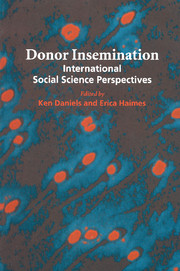Book contents
- Frontmatter
- Contents
- List of figures
- List of tables
- Notes on contributors
- Acknowledgements
- List of abbreviations
- 1 International social science perspectives on donor insemination: an introduction
- 2 The users of donor insemination
- 3 Families created through donor insemination
- 4 The making of ‘the DI child’: changing representations of people conceived through donor insemination
- 5 The semen providers
- 6 The medical management of donor insemination
- 7 Regulation of donor insemination
- 8 Donor insemination and ‘public opinion’
- 9 Concluding comments
- Index
9 - Concluding comments
Published online by Cambridge University Press: 04 August 2010
- Frontmatter
- Contents
- List of figures
- List of tables
- Notes on contributors
- Acknowledgements
- List of abbreviations
- 1 International social science perspectives on donor insemination: an introduction
- 2 The users of donor insemination
- 3 Families created through donor insemination
- 4 The making of ‘the DI child’: changing representations of people conceived through donor insemination
- 5 The semen providers
- 6 The medical management of donor insemination
- 7 Regulation of donor insemination
- 8 Donor insemination and ‘public opinion’
- 9 Concluding comments
- Index
Summary
As editors we had three aims in preparing this book: to provide the first systematic social science analysis of DI, as the oldest and most widespread technique of assisted conception; to provide an international perspective on DI, given its worldwide status in terms of practice; to make a significant contribution to the widespread debates on practice and policy in the field of DI and to the field of assisted conception more generally. It is clear to us, however, that we have not said everything there is to be said about DI. The purpose of this final chapter, therefore, is not to round off the debates but rather to show how the contributors to this book have advanced the discussion in certain areas and to identify those areas that would still benefit from further investigation and analysis.
Perhaps the first striking feature of this collection is the way in which several contributors have used the ‘first story’ of DI to orient themselves in terms of the story that they then wish to tell. That first story has given rise to a multiplicity of stories, written and told from a multiplicity of perspectives. It is now very clear that there is no longer one single way of explaining and accounting for DI. All sorts of people have all sorts of things to say about DI, ranging from describing their personal experiences, to expressing views on professional responsibilities, to arguing about ways of ensuring the adequacy of public policy, to speculating about these practices as an ordinary member of the community.
- Type
- Chapter
- Information
- Donor InseminationInternational Social Science Perspectives, pp. 173 - 178Publisher: Cambridge University PressPrint publication year: 1998
- 1
- Cited by



